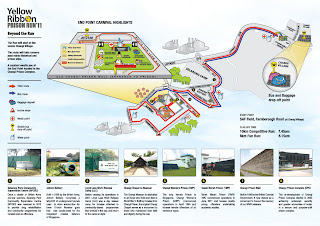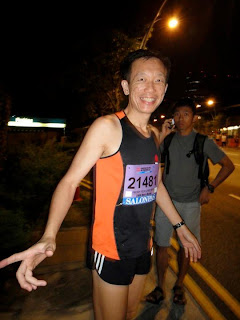In my long-term observation of aging athletes, I stay steadfastly fascinated by athletes in their forties, and beyond. The top age-groupers in triathlons and running, occasionally, return with terrifying times that match even those in their 20’s and 30’s. Sister Madonna Buder inspired me when she was racing in the Ironman Triathlon World Championships in Kona in her early 70’s. When I raced for the second time in Clearwater, Florida for the Ironman 70.3 World’s, Sister Buder was there, too packing enough heat in her strides to be taken seriously. My new friend, a 46-year-old senior officer, from the U.S. Armed Forces showed me how he can still run a sub-1:15 time, in the recent Singapore Bay Run (half-marathon). The ‘40-49’ and ’50-59’ age groups combined were, probably, as large as the ’30-39’ in the inaugural Mega-Tri race. Pronounced running groups like Team Fatbird has a majority of Masters-class runners who, regularly, run and race both locally and internationally.
I decided to interview three local, Masters category, amateur endurance athletes to find out what makes them tick and stick with their sporting lifestyle.
Photo (Passion Run 25K 2010): From left to right - Melvin How, KK Chin, Enrico, Freddy Yeoh
Freddy Yeoh is a humble endurance athlete, so it was hard to extract this interview from him. I consider him a positive force in the endurance community and he is encouraging. He runs to keep himself sane and healthy amidst a hectic life, balancing family, career, and passion. He explains, ‘Running just happens to be the easiest form of lifestyle that keeps me focused and maintain my self-discipline.’ He is an IT network-manager in a local multimedia firm.
Mika receives her podium award from Deca-Ironman Kua Harn Wei
Mika Kume is a 40-something, elite age-grouper from Japan who regularly stands on the podium. She is a multiple Ironman triathlete, ultra-marathoner and serial marathoner. By day, she works in a major accounting firm. She won a podium placing at last weekend’s Mega-Tri long-course event. She caught up with me on the last loop of the 27K run, and she crossed the finishing-point seconds before I did. I respect and admire her greatly.
Melvin How is a Resident Technical Officer, having worked in the construction industry for nearly 24 years. He longs for a desk-bound job so that he can totally rest his nagging, chronic heel condition (since 2009) and bounce back stronger to race. Nowadays, his approach to races is cautious with various backup plans. Alternative plans kick in to limit further damage, or else risk further injury or retire permanently from sport. This Ironman triathlon finisher has won the challenging vertical marathons on several occasions, and earned podium finishes in the Masters’ category in running.

EV: Which changes did you make as you matured into a Masters’ category athlete?
Freddy Yeoh: Well, I started out in the Master category. Nevertheless, a critical change that I noticed is that as one ages, the ability to recover decreases, be it after a hard workout, or due to injury. Hence, it is important to honestly assess one’s body system, every now and then, and ensure that one does not pile on too much, too quickly, for the body to adapt.
Melvin How: You must listen to your body more attentively, as injury tends to linger longer, or maybe never heal at all until I hang up my running shoes. Recovery between training sessions seems longer and my ability to put up with the strain seems lower, too. Thus, I review my training log from time to time to tweak, whenever necessary, and to switch to more lower-impact exercises like swimming, cycling and stretching.
Mika Kume: I became more rational after I realised I was in the Masters category. Do not go crazy such as to participate in two races in a day; or attempt Ironman Langkawi one week after completing in the Tokyo Marathon. Don't be so greedy. Relax, listen to your body, and rest, eat, and sleep.
Victor Chan: I am more cautious about potential injuries that may come because of age. Other than that, the rigour of my training, my focus and the effort I put in, is still very much the same.
How often do you train – minimum and maximum number of days?
MH: My current volume is about 12-15 hours in preparation for the Desaru Half-Ironman distance and Mount Kota Kinabalu Climbathon. I rest, at least, once a week; sometimes, twice, if the fatigue does not go away. I run less nowadays, with one Long Slow Distance (LSD) session, and one interval or tempo session. I will reduce it by one day in the lead-up to a key race, and will just stick to a routine. If I had a non-important race – like the recent Singapore Bay Run – I rested a full day.
MK: A minimum of zero days a week - but still do your stretching. And, a maximum of seven days a week, and that includes yoga & stretching.
VC: I always train 6 days a week. But I vary the levels of intensity of my training, depending on different factors like upcoming race or work commitments or family commitments.
FY: My motto is very simple: just run whenever I can. Depending on my schedule, I usually do 2-3 short runs on weekday nights and one longer run on Sunday. I noticed I used the word run instead of train as I don't really specifically train – that is, doing interval training and speedwork. Most of my runs are done at a conversational pace. That is also known as low heart rate run. The formula I used was ‘Maximum Heart-Rate Minus Age Minus 50 beats. I came across this formula from some articles a few years back. Basically, it teaches the body to adapt to running at a lower heart rate. Progressively increase your cadence and pace while maintaining a low heart rate. I used to wear a HRM-belt but ditched it, and just tell myself to relax on my runs.
Which aspects of training become important as we age: core strength and stability, flexibility, nutrition, sleep, or developing muscle strength?
MH: To err on the side of caution, plenty of rest and sleep is more important then training. Strength training & core stability work are important than aerobic exercise, as we lose 1% muscle mass every year from the age of 25 for men. If we lead a sedentary lifestyle, we may want to reduce the muscle loss by continually overloading them. Nutrition is about 65% carbohydrate, 15%-20% protein, and the remainder comes from fat. The main emphasis is on moderation, as there is no such thing as sinful food as too much of a good thing is also bad. Balance or moderation on food portion is more important. I eat 5-6 small meals a day, and try to maintain my body-fat composition within the 12-15% range year-round, to stay race fit.
MK: Oh - all are important! If I can choose two – especially for aging athletes – I think flexibility and muscle strength are more important as they protect you from injury.
FY: No specific training program or nutrition plans for me. I like to have some beer and snacks during the weekends. I seldom do strength or stability training.
VC: Everything gets more important as we age, especially our core muscles. Our core muscles affect our performance and make us more prone to injury.
Photo-credit: Richard Leong & Boon Yeong. Part 2 continues tomorrow.



























